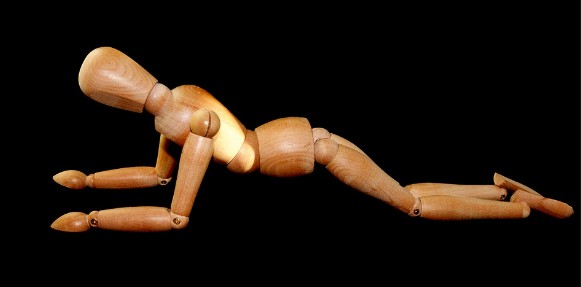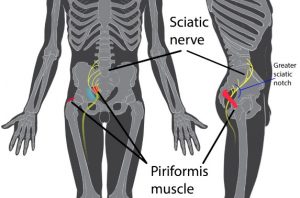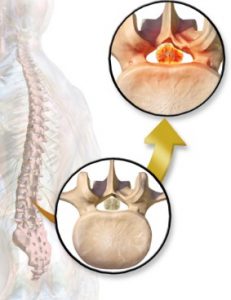It can be difficult to perform regular activities during the day if you’re always suffering from back pain. Located between the legs and the spine is the sciatic nerve and it is known to cause pain in the feet, legs and the back. Many people describe the pain as hot needles and pins. Some estimations suggest that as much as 40% of the population will suffer pain from sciatica during their lifetime.
- See What’s the Best Treatment for Sciatica? (Effective Home Remedies for Sciatica)
- See Easy Exercises For Sciatica Pain Relief
Some people will experience moderate pain that comes and goes while others will have more regular bouts of pain that is more severe. In the worst cases, a person will need to have injections and possibly even surgery. The good news is that many people can avoid the more severe issues by using measures at home as well as making lifestyle changes. The only way to begin to heal and to avoid any further issues is to first understand what causes this problem. Most will be able to handle the condition and reduce the symptoms simple with some changes in their daily routines.
What is Sciatica?
This nerve runs from the feet, up the legs, through the buttocks, and up to the lower part of the spine. It helps to give the feet and legs strength and feeling. If it gets pinched for any reason then it can become irritated. That is the most common cause of this condition. This can happen when muscles in the feet and leg become tight or in the buttocks area or back when it becomes herniated. Other conditions such as stenosis have also been known to cause sciatica.
If a nerve gets pinched in the lower back and causes leg pain, this could be sciatica. In the most terrible cases, the pain is so severe that most people won’t even want to get out of bed or off the couch. Sufferers can experience tingling, numbness, sharp pain as well as weakness in their leg or toes. When the condition gets to be this severe, the sufferer should consult with a physician or other health care professional.
Symptoms of Sciatica
Anytime you feel pain in the area of the sciatic nerve or in your leg, foot, or buttocks it’s possible it’s a symptom of sciatica. Some people experience a condition where their heels or ankles are no longer flexible enough to support their weight and they have to try to walk without using that part of the foot. Others experience weak knees as well as limited mobility around the knees. When these symptoms are present the individual will need to be very careful as it is easy to fall and further injure one’s self.
What Exactly Causes Sciatica?
Some of the causes include an imbalance in the muscles. Some muscles may become weak and that leads to their tightening and then normal muscles have a give and take action against these weaker and tighter muscles and some of them will simply no longer be able to work like they should. This condition can then lead to pressure in the area around the sciatic nerve which then leads to pain. If the pain is mild a hot bath or even meditation could be enough for immediate pain relief.
Some Specific Causes For Lower Back Pain Related To Sciatica
- Spinal Stenosis
- Degenerative Disc Disease
- Slipped Or Herniated Disc
- Osteoarthritis
- Spondylolisthesis
Other conditions such as blood clots, abscesses, and tumors can also be included in the causes of this condition. While these are the most common, there are numerous causes that lead to sciatica. Finding the root cause can help you determine if it is treatable at home or if the help of a physician will be needed.
When to See a Doctor about Sciatica?
When you understand the causes and the fact that treatments for sciatica in the majority cases can be successfully treated at home, then you can begin to look for the specific things you should be doing for your particular case. But if the following circumstances happen, then it is recommended that you seek out a healthcare professional.
- If someone is under the age of 20 or over the age of 55 and it’s the first time they’ve ever experienced this condition, then they should seek out the advice of a physician. Young people especially, tend to put off a visit to the doctor but in this case, they should not.
- If the one who is experiencing pain is also losing a lot of weight then this is a clear sign they need to go to a physician. There may be some other issue at work. Unexplained weight loss is usually due to another illness, but sometimes if the pain is constant enough it might be enough to cause the weight loss.
- If the pain persists for longer than 2 weeks.
- If the one in pain also has HIV.
- If the pain gets worse after several days.
If you or someone close to you has any of the following conditions then you will need to go to an emergency room as soon as possible.
- If the pain is in the back of the chest.
- If you are no longer able to move your legs or feet.
- If you lose control over your bowel movements or have numbness in your genitalia.
- If you run a temperature of over 101 degrees.
- If the pain becomes unbearable.
For most situations where a healthcare professional is needed, Chiropractors will likely be the best choice. They will focus on manipulating the back manually and they will realign the spine. You will first need to consult with the physician about the pain as it might be related to some other medical condition. Having a complete medical examination will rule out any other conditions or it will discover them. Discovering a problem you are unaware helps to begin its treatment.
The doctor will be able to say with certainty if the cause of your condition is from sciatica. There are some conditions that feel very like sciatica but are different. Piriformis syndrome is a condition that is separate but because it presses on the sciatic nerve it often appears to be the condition of sciatica. In this case, heat therapy or injections of an anti-inflammatory can be used but may not be as effective as a chiropractor. If you have never been treated by a chiropractor you should make an appointment.
If none of the most severe conditions are present, then the condition and pain can likely be taken care of at home. If you’re experiencing stabbing pain or burning sensations, then those things will be relieved just as soon as pressure is taken off the sciatic nerve and when inflammation is reduced. While there are over the counter medications someone can take, there are also natural cures that have no pharmaceuticals drugs in them.
How to Diagnose Sciatica?
Arranging a doctor’s appointment for a full medical examination is the best way to determine the cause and firmly diagnose the condition of sciatica. The health care professional will perform a variety of tests and exams to help determine if it is sciatica. It’s possible that the doctor may decide to schedule an x-ray to make sure there are no fractures or they may schedule an MRI where a CT scan. Another test that might be performed is with the use of die that’s injected so the doctor can see if there’s a disk or vertebra that is leading to the pain. In most cases, however, a basic test will be done and a diagnosis will be made.
Tips to Prevent Sciatica
Some causes such as back strain from pregnancy, certain accidents, and degenerative diseases are not always preventable. Even so, there are a number of things you can do to protect yourself and to reduce the chance of having this condition. Simple preventative measures such as not wearing high heels or sitting for long periods of time as well as maintaining good posture are all things that can help. Taking part in yoga or stretching classes or other types of physical maintenance can be helpful.
If you lift weights, make sure that your techniques are correct and don’t smoke. Exercise, when done right, strengthens the back and the abdomen which can help to prevent this condition. Stress leads to a lot of physical ailments including this type of condition, so keeping your emotions elevated and your stress levels down is very helpful.
Final Thoughts
The pain from this condition can be quite debilitating and for this reason, as soon as you start noticing symptoms get in touch with a healthcare professional such as a chiropractor or physical therapist. Getting treatment early can significantly improve the condition. Remember that while the most severe cases will need the examination and treatment of a physician, most will not.







